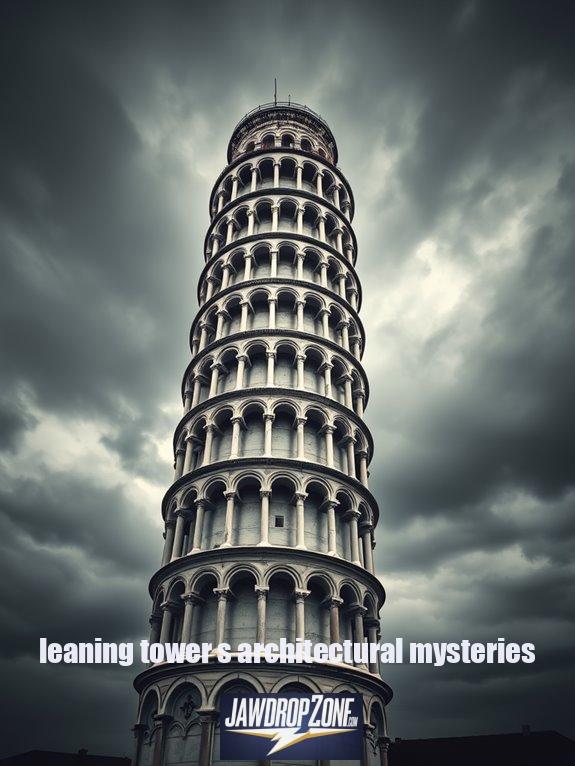The Leaning Tower of Pisa isn’t just an architectural blunder; it’s a stunning mix of history and genius! Did you know construction started in 1173, but before it even finished, the tilt was already a problem? Envision that! With a breathtaking design comprising 207 columns, it pulls in millions of shocked visitors every year. Ever thought about climbing those 300 slippery steps? You’ll get views that make gravity seem like a joke. Stick around to uncover more jaw-dropping secrets!
Quick Takeaways
- The Leaning Tower was originally intended to be vertical, but the lean began after just two floors were completed.
- It features 207 columns and intricate Romanesque architectural elements, making it a stunning visual masterpiece.
- The tower’s initial stability issues stemmed from its shallow foundation built on sandy soil, prompting centuries of concerns.
- A comprehensive restoration project from 1990 to 2001 successfully reduced the lean from 5.5 degrees to less than 4 degrees.
- Climbing nearly 300 steps offers visitors unique views and an exhilarating experience of defying gravity at its summit.
Secrets Behind the Leaning Tower’s Marvel

Envision this: a stunning bell tower that defies gravity, tilting ever so slightly, daring us to question the very laws of physics. Welcome to the Leaning Tower of Pisa, an engineering marvel and a source of endless fascination. It wasn’t always this lean, mind you. Construction began back in 1173, and the intention was to erect a perfectly vertical tower, but things don’t always go as planned, do they?
Marvel at the Leaning Tower of Pisa, an architectural wonder that challenges gravity since construction began in 1173.
As the builders progressed to the second floor, the foundation—oh, that infamous layer of sandy soil—decided to play villain and spoil their grand ambitions. Picture the disbelief as they realized their tower had started to lean, not exactly the architectural crown jewel they perceived. In their attempt to remedy the disaster, one side was made taller, but that only made matters worse. It’s like trying to fix a crooked picture frame by forcing it farther askew—simple physics telling them to rethink the strategy.
This iconic structure is more than just an engineering flaw; it’s a demonstration of Romanesque architecture that beckons millions of visitors each year. Can you believe it boasts a staggering 207 columns? And those arches—oh, you’d find yourself entranced by the elaborate details crafted from luminous white marble that gleams under the Tuscan sun. Today, it is recognized worldwide as a symbol of Pisa and Italy.
When I launched Jaw Drop Zone, I wanted to uncover wonders like this, and let me tell you, it didn’t disappoint!
Consider this: it took centuries of efforts to stabilize the tower—one that was initially thought unfixable. Between 1990 and 2001, a dramatic restoration project reduced its lean from a jaw-dropping 5.5 degrees to less than four. Yes, they actually excavated soil from beneath its foundation, pulling off quite the engineering heist. Shouldn’t we applaud such ingenuity? The very act of stabilizing this tower has become an art form, showcasing human grandeur against the odds.
Fun fact: the largest bell in its belfry weighs over 3,600 kilograms—picture the power it must command! Now envision climbing nearly 300 steps through two spiral staircases to stand at the top. The sheer thrill of looking down at a world where gravity appears trifled with—now that’s triumph in the face of chaos.
Pisa’s Architectural Stability Secrets

As you explore the Leaning Tower of Pisa, it’s hard not to marvel at the secrets hidden beneath its slanted facade. Did you know the very soil beneath it, filled with clay and fine sand, set the stage for a construction drama?
The shallow foundation, heavier than a bad decision, caused the infamous lean that almost crushed its dreams.
Picture this: construction halted for a century! Yup, wars and funding woes gave the ground time to settle, which surprisingly worked in its favor.
Thanks to an international effort in the late 20th century, the tower’s tilt was reduced to less than 4 degrees, extending its reign.
Curious how this masterpiece survived? Trust me; it’s a tale worth sharing!
References
- https://www.historyhit.com/locations/leaning-tower-of-pisa/
- https://study.com/academy/lesson/leaning-tower-pisa-overview-facts.html
- https://touritalynow.com/blog/italy-fun-facts/5-fun-facts-about-the-leaning-tower-of-pisa/
- https://questoapp.com/blog/leaning-tower-of-pisa-facts
- https://ohmyfacts.com/world/45-facts-about-the-leaning-tower-of-pisa/
- https://www.britannica.com/topic/Leaning-Tower-of-Pisa
- https://www.geopier.com/resources/articles/is-it-an-inch-or-a-mile
- https://www.walksofitaly.com/blog/art-culture/leaning-tower-of-pisa-facts
- https://www.discovermagazine.com/planet-earth/the-leaning-tower-of-pisa-wasnt-supposed-to-lean



